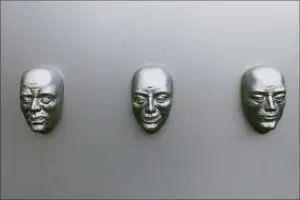Dissociative Identity Disorder Symptoms, Treatment, and Causes
Dissociative Identity Disorder Symptoms, Treatment, and Causes
A complex psychiatric condition, once referred to as multiple personality disorder, Dissociative Identity Disorder (DID) is often misunderstood and even considered, incorrectly, a myth in some circles.
 Research over the last 40 years has proven this condition is very real and can be the source of significant anguish and impairment in day-to-day life. This is especially true for victims of severe physical or sexual abuse during childhood.
Though it’s difficult to know how many people suffer from Dissociative Identity Disorder symptoms, the Diagnostic and Statistical Manual of Mental Health (DSM-5), the most widely used manual for diagnosing mental illnesses, estimates that around 1.5 percent of adults in the U.S. live with DID in a given year.
Research over the last 40 years has proven this condition is very real and can be the source of significant anguish and impairment in day-to-day life. This is especially true for victims of severe physical or sexual abuse during childhood.
Though it’s difficult to know how many people suffer from Dissociative Identity Disorder symptoms, the Diagnostic and Statistical Manual of Mental Health (DSM-5), the most widely used manual for diagnosing mental illnesses, estimates that around 1.5 percent of adults in the U.S. live with DID in a given year.


 Research over the last 40 years has proven this condition is very real and can be the source of significant anguish and impairment in day-to-day life. This is especially true for victims of severe physical or sexual abuse during childhood.
Though it’s difficult to know how many people suffer from Dissociative Identity Disorder symptoms, the Diagnostic and Statistical Manual of Mental Health (DSM-5), the most widely used manual for diagnosing mental illnesses, estimates that around 1.5 percent of adults in the U.S. live with DID in a given year.
Research over the last 40 years has proven this condition is very real and can be the source of significant anguish and impairment in day-to-day life. This is especially true for victims of severe physical or sexual abuse during childhood.
Though it’s difficult to know how many people suffer from Dissociative Identity Disorder symptoms, the Diagnostic and Statistical Manual of Mental Health (DSM-5), the most widely used manual for diagnosing mental illnesses, estimates that around 1.5 percent of adults in the U.S. live with DID in a given year.
What is Dissociative Identity Disorder (DID)?
The Harvard Review of Psychiatry describes Dissociative Identity Disorder as a “posttraumatic, developmental disorder.” It is characterized by a person that exhibits two or more distinct identities or personality states that alternately take control over the individual. Each separate personality is likely to have it’s own identity, history and self-image. Alternate personalities may display different types of knowledge or vocabulary and their reported age and gender may even differ from a person’s principal personality-state. Generally, the primary identity of a person with DID carries their given name, struggles with depression, feelings of guilt and is somewhat passive. A person’s various identities may deny knowledge that any other personalities exist, and, in fact, significant memory loss can be associated with this disorder. Some DID patients have no recollection of how they ended up in a certain location because an alternate personality was in control during the travel. In other cases, a person’s distinct identities might not just be aware of the other identities, but may speak or think poorly of them. Alternate identities might also claim to be in open conflict with the competing personalities. Another common aspect of DID is that particular situations, stressors or circumstances can trigger or bring out a specific personality.Dissociative Identity Disorder Definition
Different cultures are known to perceive shifts in personality-states as spiritual or supernatural possession. Acceptance of these states can vary based on the culture and its religious beliefs and practices. For some patients with DID, the shift between identities is subtle and might go unnoticed by others around them. These are called non-possession-form cases. On the other end of the spectrum is possession form DID, where the shift between identities is obvious to everyone. This type of personality change may come involuntarily, appearing in a time or place that seems inappropriate and cause the individual severe distress. Patients with this disorder experience identity changes in different ways. Some feel a sort of “out of body” sensation, as if observing their behavior and speech from a distance. Others report feeling a difference in how they hold their body and how it feels. They may also hear incoming voices or have thoughts that seem out of their control as an alternate identity is moving forward into consciousness.
Symptoms of Dissociative Identity Disorder
Like other mental health disorders, the DSM-5 lists the specific criteria required in order for a diagnosis.In the case of Dissociative Identity Disorder symptoms, all of the following must be present:
- The presence of two or more separate identity states, each having its own perception of self and the environment
- Disruptions in the identities include changes in consciousness, motor function, cognition, memory, and behavior among the various personality states
- Memory gaps that involve people, places and situations from both the recent and distant past, along with memory gaps associated with other identities and their personal history
- The symptoms of Dissociative Identity Disorder must be severe enough to create social or occupational impairment, create distress, or complications in other areas of life
What Causes DID?
One of the reasons the diagnostic term for DID changed from multiple personality disorder was to better define the disorder. Rather than thinking that a person develops multiple personalities, researchers now know this condition is more of a fragmenting or splintering of a person’s identity, in many cases because of repeated trauma. It is not completely understood what causes Dissociative Identity Disorder or why some individuals develop it, but severe and sustained childhood trauma is not uncommon in patients with this condition. Whatever the cause of DID, it can appear at any age. Very often, people with DID also suffer from post-traumatic stress disorder (PTSD), and experience nightmares, flashbacks and other symptoms related to past traumatic events. Because the chief trait of DID is a person with two or more personalities that function independently of the other, one or more of the identities may be problematic, acting impulsively and struggling with co-occurring illnesses, such as PTSD, anxiety, depression and substance abuse or addiction. “Among the most frequent diagnoses found in patients with DID are substance use and dependence,” according to the authors of Dissociative Identity Disorder and Substance Abuse: The Forgotten Relationship, published in the Journal of Psychoactive Drugs. “Ignoring either diagnosis is likely to be detrimental to patients; both disorders and their coexistence need to be addressed.”
What is the Treatment for DID?
The goal of Dissociative Identity Disorder treatment is to deconstruct alternate identities and assimilate them into one personality. This is primarily achieved through long-term psychotherapy that can include cognitive approaches to recovery, as well as creative, art-based therapies. Some medications may play a role in treating the symptoms of depression, anxiety and PTSD that often accompany this condition as well, although there are not any particular medications that directly treat the symptoms of DID.The most effective therapies for Dissociative Identity Disorder treatment include:
- One on One or Group Talk Therapy
- Cognitive Behavioral Therapy (CBT)
- Dialectical Behavior Therapy (DBT)
- Eye Movement Desensitization and Reprocessing (EMDR)
- Art Music Therapy
- Brainspotting Therapy for Trauma
- Trauma and Addiction Treatment
- Family Therapy
- Meditation and Mindfulness
- Hypnosis
- Neurofeedback Therapy
- TMS Therapy (Transcranial Magnetic Stimulation)




